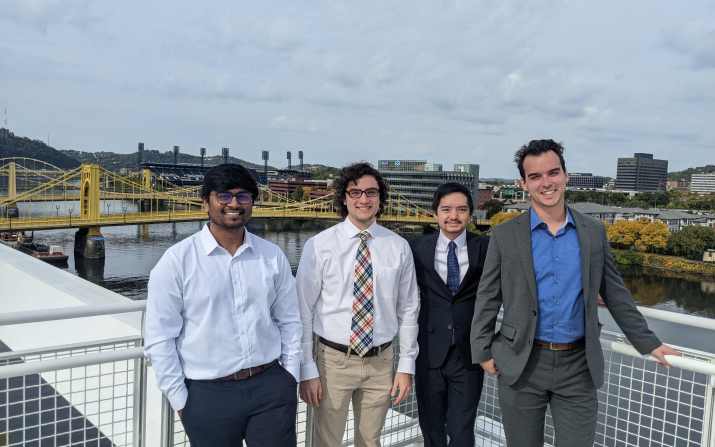Students present at MS&T

Multiple students in Case Western Reserve University’s Department of Materials Science and Engineering had the opportunity to present their research and make connections in the materials community at the annual Materials Science and Technology conference in Pittsburgh, Pa.
Ph.D. student Austin Ngo gave three presentations, “Effects of Process Parameters on Fatigue Behavior and Defect Characteristics in LPBF Ti-6Al-4V,” “Machine Learning Segmentation Methods for Fatigue Fracture Surface Defect Analyses” and “Influence of Post-Processing Techniques on Process-induced Defects in AM AlSi10Mg and CP-Ti,” all of which focused on his mechanical testing research in CWRU's Advanced Manufacturing and Mechanical Reliability Center. He did a significant amount of mechanical testing and processing to prepare, including fatigue and fracture tests, metallography, and forging and heat treatment processes. Many attendees at his presentation asked insightful questions and gave him recommendations for research tools to use for improving his data analysis process.
Ph.D. candidate David Scannapieco’s presentation, “Modified Rosenthal Solution for Prediction of In Situ Alloyed GRCop-42 Melt Pool,” presented some new challenges for him as he prepared. Typically considering himself an experimentalist, he studied thermodynamic models for weld pools in additive manufacturing. He ended up learning new ways to manipulate models and the hierarchical order for them. “Some methods are physics-based which helps justify the model, others are ‘experimentally validated’ despite not having a strong physics-based justification,” he explained. “Both methods have some merit and it depends on the overall project for which is more appropriate.” Giving his presentation to modeling experts gave him an opportunity to learn from scientists in the field.
Having attended the conference in 2021 as an observer, M.S. candidate Kaiser Aguirre gave a presentation this year, "Characterization of Nb-Si Alloys for High Temperature Applications." As he prepared his presentation, Aguirre conducted mechanical testing and electron microscopy of fifteen alloys to determine how properties change with composition. He ended up discovering that room-temperature properties do not always predict high-temperature properties, that plasticity can be retained despite significant increases in yield strength and that the rate of change of hardness as temperature increases can be changed by varying alloy composition. Multiple audience members at his presentation were interested in how specific alloying elements change mechanical properties.
Ph.D. candidate Tauhidul Islam researched Fe-Ga based magnetostrictive materials for his presentation, "Structural and Magnetic Properties of Fe-Ga-Zr Nanocrystalline Alloys." To prepare, Islam worked to achieve soft-magnetic properties from magnetostrictive galfenol. He was pleased when audience members at his presentation asked questions related to his analysis. He was pleased to see faculty members from his M.S. alma mater, Missouri State University, at the conference.
In addition to their own presentations, students enjoyed attending presentations from other materials scientists. Ngo enjoyed a symposium focused on applying machine learning techniques to additive manufacturing. Having completed an internship focused on dissimilar metal welds using additive manufacturing a few years back, Scannapieco enjoyed attending a presentation focused on that topic and seeing "how far the work has come and the levels of success that have been achieved nowadays.”
Students who did not give presentations of their own still found the conference to be a valuable experience. Sophomore Jonah Gezelter described an oral presentation focused on pressure-quenched silica glass that displayed ductile behavior as “really cool,” while BS/MS candidate Jackson Smith enjoyed attending presentations from researchers outside her lab, AMMRC. “I usually only know about the research done by grad students in AMMRC so it was really interesting to learn about other topics,” she said.
One evening, a reception was held for CWRU alumni to mingle with current students and faculty. Scannapieco, who also earned his B.S. at CWRU, was happy to catch up with recent graduates that evening and said that the graduates were excited to hear about recent renovations. Aguirre enjoyed the opportunity to meet a CWRU alumnus who is a Materials & Processes Engineer at Sierra Space, where he interned as an undergraduate. Islam described the reception as “really nice,” while Smith was pleased that many CWRU alumni showed interest in her research.
"I greatly enjoyed the department alumni event and had a chance to meet older graduates with established careers,” said Ngo. “They were interested to learn of the changes in the department over the past few years, such as new faculty and the building renovations.”
The conference drew attendees from across the United States and around the world. “It was nice having so many people at the conference,” said Ph.D. student Harrison Teutschbein, who pointed out that being in person “helped to liven the atmosphere significantly” compared to online conferences he attended.
"There is no alternative to the brief hallway conversations that occur after a presentation or during the breaks, that is where I got all my great advice and connections,” added Scannapieco. Aguirre, who met up with a friend from his undergraduate studies at Iowa State University, agreed, pointing out that in-person interactions are “so much more meaningful and memorable.”
